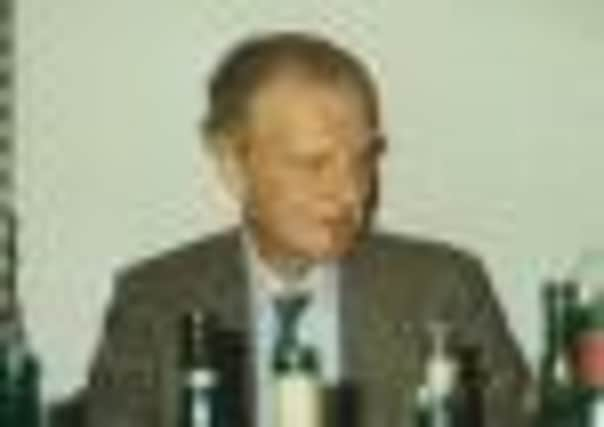Obituary: Jan Read, writer who helped adapt Dr Finlay’s Casebook for television


Jan Read was a successful scriptwriter, who wrote the sword-and-sandals adventure Jason and the Argonauts, helped create Dixon of Dock Green and played a key role in persuading the BBC to make Dr Finlay’s Casebook, the classic series about a couple of doctors in a small Scottish town in the 1920s.
He had a great love of Scotland. Although he was born in Australia, he grew up in St Andrews and returned to live there later in life. He felt equally passionate about Spain, having married a Spaniard. He wrote books on Spanish history for the English-language market and was involved in the early stages of the epic Charlton Heston film El Cid.
Advertisement
Hide AdAdvertisement
Hide AdHe also wrote about wine and did much to popularise Spanish wine at a time when it was little-known in the UK. Jancis Robinson, TV wine expert and editor of the Oxford Companion to Wine, wrote on her website: “Anyone who became interested in Iberian wine before around 1985 will almost certainly have depended heavily on Jan Read’s scholarship.”
As if being a distinguished scriptwriter and wine connoisseur were not enough, Read had trained originally for a very different career – as a scientist. And he did secret research work during the Second World War.
He came from a distinguished scientific family. His father was the eminent English chemist, John Read, who was professor of chemistry at the University of Sydney, when he was born.
The son was named John Hinton Read, but styled Jan, a reference to the family’s English West Country roots. His younger brother, Arthur, worked at the Bletchley Park code-breaking centre; he was one of Britain’s top chess players and a mountaineer. He was later killed in an avalanche.
The family moved back to the UK in the early 1920s and John Read Senior took up the post of professor of chemistry at the University of St Andrews.
His son attended Glenalmond public school, studied science at Cambridge Universtiy and then back in St Andrews, where he ran the university film club.
In 1937 he made a short silent documentary called Ad Vitam, meaning “to life”. It traced the history of St Leonard’s girls school in St Andrews and is now in the Scottish Screen Archive.
He taught physics at Sheffield University and, during the Second World War, worked on the development of new, cheaper explosives and camouflage.
Advertisement
Hide AdAdvertisement
Hide AdAfter the war, Jan Read went to the US on a film scholarship and worked with Elia Kazan and Fritz Lang. Back in Britain, one of his first projects was the 1950 film The Blue Lamp, with Jack Warner as the avuncular PC George Dixon.
The screenplay is credited to TEB Clarke, one of Ealing Studios’ most celebrated writers, though the opening credits acknowledge that the original treatment was the work of Read and Ted Willis. Read drew on his experiences in the US for the realistic quasi-documentary tone.
Dixon was killed at the end of the film, but was so popular that it was decided to bring him back to life and give him his own television series, Dixon of Dock Green, which ran from 1955 to 1976. Read was not directly involved in the TV spin-off.
Over the next 20 years he worked on dozens of films and television shows, including Jason and the Argonauts. In writing it, Read drew heavily on stories from A Handbook of Greek Mythology, which was written by HJ Rose, professor of Greek at St Andrews University and a family friend.
Jason and the Argonauts is one of the classics of the genre, with its famous stop-motion animation creations – the many-headed Hydra, the skeleton warriors, the winged harpies and the giant statue that comes to life.
It remains popular on DVD and TV.
With the decline of the British film industry in the 1960s, Read worked increasingly in television, writing for The Adventures of Robin Hood, Danger Man, Sherlock Holmes and of course Dr Finlay’s Casebook, which followed the eponymous young doctor (played by Bill Simpson) from Glasgow to the small, fictional town of Tannochbrae.
It was ostensibly based on stories by AJ Cronin, but Read also drew on childhood memories of eccentric St Andrews academics and of the doctor who came to look at his sore throat, asked him to lie on the table and without further ado took his tonsils out.
It proved enormously popular and ran for almost 200 episodes from 1962 to 1971. Read wrote some of the earlier episodes. There was a new series in the 1990s, with David Rintoul.
Advertisement
Hide AdAdvertisement
Hide AdRead also wrote episodes for Scottish historical adventure series, The Borderers, in 1970, but by that time his writing career was starting to head off in a different direction.
In 1956, Read had married Maite Manjon, a nurse from Spain, and he developed an interest in Spanish history, culture, wine and cuisine.
His book, The Wines of Spain and Portugal, came out in 1973 and helped develop a market in the UK for the region’s wine. He did much the same for Chile with his book, Chilean Wines, in 1988.
His wife wrote books on Spanish cuisine and sometimes they collaborated, producing several books covering food, wine, travel and history. They also wrote Visitors’ Scotland and The Great British Breakfast.
Read moved back to St Andrews in the 1980s, and his autobiography, Young Man in Movieland, was published in 2003.
He is survived by his wife, Maite, and by their son, Carlos Read, a wine importer.
BRIAN PENDREIGH